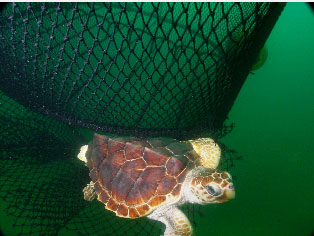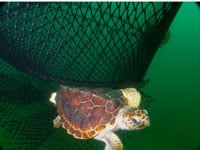While sea turtle deaths have been reduced, researchers say more needs to be done
Turtle excluder devices (TED), the use of circle hooks in longline fishing equipment, dehooking devices, and other preventative measures have helped to reduce the mortality rate of sea turtles that are accidentally captured in fishing trawling nets and long lines, according to a report published in the scientific journal Biological Conservation.

Photo courtesy NOAA
A sea turtle escapes via a turtle excluder device in a trawling net.
The report, "Cumulative estimates of sea turtle bycatch and mortality in USA fisheries between 1990 and 2007," estimates that approximately 4,600 sea turtles die each year in coastal waters in large part due to accidental capture of these animals by commercial fishing vessels, a 90 percent decline since 1990 in fisheries that have adhered to certain regulations designed to reduce the number of sea turtle deaths. Overall, turtle bycatch has been reduced by roughly 60 percent, the report said.
It is estimated that prior to the introduction of Turtle Excluder Devices and other measures, more than 300,000 sea turtles were caught in commercial fishing gear in more than 20 U.S fisheries (waters of the Atlantic Ocean from the Gulf of Mexico up to Canada and Pacific Ocean along the West coast and off the waters of Hawaii) each year, with 70,000 of those turtles killed. Shrimp trawls in the Gulf of Mexico and southeastern United States accounted for 98 percent of all bycatch and turtle deaths over the last 20 years, the report said.
While the report shows signs of improvement in reducing the death of these reptiles, the researchers who conducted the report say that there is still room for improvement. Researchers questioned shrimp trawl bycatch estimates because not all trawlers have independent observers onboard to count bycatch, and not all boats were compliant with TED regulations in certain fisheries, meaning that the actual bycatch was most likely higher than reported in the study. The report cites the need to manage sea turtles on a more unified scale rather than the fishery by fishery basis that is currently the norm. This fragmented approach, the researchers claim, leads to a total allowed take quota that exceeds what sea turtle populations can sustain. The current approach does not take into account how the overall population of these animals are affected. The researchers want bycatch limits to be uniform throughout the United States across all fisheries to ensure that bycatch reductions help sea turtle populations to successfully recover.
The report, conducted by researchers at Duke University’s Project GloBAL (Global By-catch Assessment of Long-lived Species) and Conservation International, is the first attempt to make a cumulative estimate of sea turtle bycatch and mortality that occurs within fisheries in the United States.
The full report can be downloaded via PDF here.


